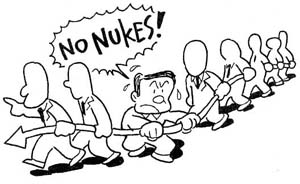|
Recently I agreed to become a member of the government's Long-Term Program for Research, Development, and Utilization of Nuclear Energy (Long-Term Program). I joined at the request of the secretariat of the Japan Atomic Energy Commission (AEC) and I hope to use my new position as a platform to speak out against Japan's nuclear power development strategy. Although I am the only member of the Long-Term Program from an anti-nuclear organization, I am also the first, a fact that reflects growing public disenchantment with Japan's nuclear energy policy.

Cartoon by Shoji Takagi
The Long-Term Program was drafted in 1956 and has been revised every five-to-seven years since. This will be the tenth revision of the plan. Until 2000, the program set power output goals (for instance, by 2030, the objective was pegged at 100 million kW), but since 2000 utilities have been left to develop their own goals. Nonetheless, reprocessing and work on fast-breeder reactors still remains a national responsibility.
The Long-Term Program has been implemented by people referred to collectively as the nuclear power lobby (in Japanese, literally, "nuclear power village"). In other words, the government has used national research funds to finance research and development within the framework of the plan, but has not funded related projects outside that framework. As a result, the Long-Term Program has become a de facto lobby for interest groups working in nuclear-related industries. By adding an anti-nuclear activist to its membership, the Long-Term Program has made a major concession to nuclear power foes. Of course, the Program will probably continue in its role as the distributor of benefits, but with the most recent revision, the Program itself has assumed a new importance. It will decide the fate of Japan's nuclear fuel cycle policy.
In the context of the nuclear fuel cycle, media reports indicate that the focus of the current revision to the Long-Term Program will be the national reprocessing policy. Since 2000, the debate on spent-fuel reprocessing has changed dramatically, as evidenced in three recent developments. First, construction costs for the Rokkasho Reprocessing Plant in Aomori Prefecture have soared and are now expected to exceed 2.14 trillion yen. Next, even some nuclear power advocates believe that reprocessing is not necessary at the present time. Finally, a group spearheaded by young Diet members of the ruling Liberal Democratic Party has begun expressing doubts about the wisdom of reprocessing.
Long-Term Program Chair Shunsuke Kondo has recently announced that the Program will undertake a comparison of the costs involved in reprocessing and in 'once-through'1 technology.
To date, the Long-Term Program has already convened twice. Just before the second meeting, it was revealed that the Ministry of Economy, Trade, and Industry (METI); the Federation of Electrical Power Companies, Japan; and the AEC had hidden the fact that they had conducted cost surveys for once-through technology. In fact, they had carried out such studies between 1994 and 1998. METI actually perjured itself in testimony before the National Diet saying, "No such calculation has been made for Japan." As a result, these organizations are scheduled to make their cost estimates public. Moreover, the Atomic Energy Commission is apparently conducting its own up-to-date cost survey. Construction of the Rokkasho Reprocessing Plan is now 95% completed. Will the facility begin reprocessing spent nuclear fuel, or will it be shut down for good? That question will be debated by the Long-Term Program in the coming months.
1. 'Once through' refers to direct disposal of spent fuel, without reprocessing it to extract the plutonium, etc.
Return to NIT 101 contents
|
|

